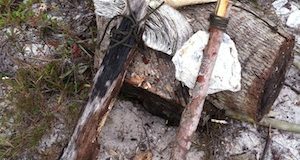|
Listen To The Article
|

Clubs
Clubs are the oldest dual-purpose weapon and can be the easiest to construct, although it can become more complicated when you aim for higher quality. A club wouldn’t be my first choice as a weapon due to its short range, but it’s far better than your bare hands.
A club can be used to finish off any angry game you catch in your snares and can be used to open shellfish if available. A club is also a valuable tool should you need to break any kind of rock or plant stakes into the ground.
Three different kinds of clubs are available: the simple club, the weighted club, and the sling club. The simple club is just that—a piece of wood used to bash things. Choose a branch, one short enough to swing with ease but long and strong enough to inflict enough damage on your target. The simple club needs to be thick enough to take the blow, but thin and flexible enough that it won’t snap after only a few swings.
The weighted club is my favorite of the clubs. The weighted club can be nothing more than a long branch with a heavy root attached, or you can make something a little more powerful by tying a rock to a handle. Making one of these weighted clubs is easy, but making a good weighted club may take some practice.
The first step is finding an appropriate handle to use. The same standard for the simple club is used here. The second is finding an adequate rock. In this case, the shape of the rock needs to be similar to that of an hourglass. This is necessary to securely tie it down. If an hourglass shape can’t be found, you must use another rock to carve or peck a groove into it.
As I mentioned, you’re going to need some kind of cordage, whether it’s natural or produced, and it needs to be tough and able to stay tight and secure. I depend on two lashing methods, the split handle and the forked branch. The split half is exactly that: you split the top of your handle carefully down the center. Next, you insert your stone into the handle and then lash across, below, and above the stone. The forked branch is also self-explanatory: the fork must be tight enough to hold the rock while still loose enough for the rock to slide into it. To finish it, push together the fork and lash the top together.
The final club is the sling club. This club makes your reach longer and the impact of the blow harder. This one is simple to make. Again, the standard for the handle stays the same, and you still need an hourglass-shaped rock. You simply lash a cord to the handle and then to the rock, leaving about ten inches of cord between the club and rock.
Bola
The bola is a primitive weapon from South America, often used for cattle. I’ve grown to love the bola: it is just so effective and easy to make and use. The one I’m teaching you to make is designed to take down small game and even low-flying fowl in a flock.
The bola is essentially three rocks, each tied to a separate piece of rope. The three ropes are then tied together with the rocks at the ends. You use the weapon by spinning it above your head. Release the bola, and the weighted cords will separate, wrapping around or striking the game you’re aiming for.
The weapon takes some practice to master, but at short range, it’s exceptionally effective. In fact, my interest in primitive hunting has grown since making and practicing with this weapon. I would love to try my hand at taking down live game with it.
Knife
A field-expedient knife shouldn’t be held to the same standard as a metal commercially bought knife. A normal knife can puncture and cut; it’s more than likely that your field-expedient knife will only puncture.
A bone knife is the first knife I successfully made. The bone is easy to form into a blade. The best bones to use are large bones, like deer legs. I made my first bone knife from a jawbone.
I used my club to carefully shatter the bone into a rough blade shape, and then I rubbed the blade against a hard rough rock to smooth out the blade and sharpen the tip. A bone knife doesn’t hold an edge, so it is only useful to puncture.
A stone knife takes a bit of skill and practice to make. I will honestly say I have not fully mastered this art yet. You will need a chipping tool and a flaking tool. A flaking tool is a pointed tool made from bone or metal and used to break off thin, flat pieces of stone. A chipping tool is made from wood, bone, or metal and is used to break off small pieces or chunks of stone.
You first must shape the blade by striking glancing blows with the chipping tool near the edge. This will get it thin enough to sharpen. After the blade is formed, sharpen it by pressing downwards with the flaking tool. Again, this will take some time to master, but there are many advanced lessons available in print or online if you are interested.
I hope you’ve learned something about making field-expedient weapons. I learned a lot building them for this article. I’ll be honest and say that I cut and banged my hands up along the way, but was well worth it. I suggest trying it yourself—get practice at building and operating them.
©2013 Off the Grid News